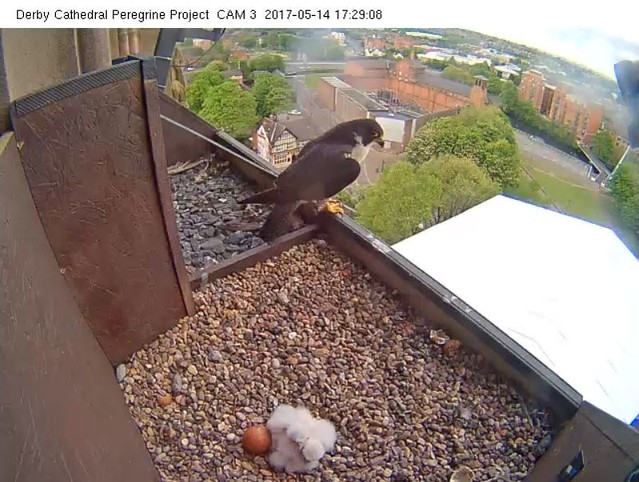Five eggs were laid over a 15 day period (that in itself is strange - ours lay their four eggs every other day) and now only one egg has hatched!).
(There was also a very clear mention of the fact that birds of prey (in this case golden eagles) have been 'disappearing' on managed driven grouse moors in Scotland.....though Chris Packham had to stay well clear of that item, understandably given the flak he's received for being 'political' and using his BBC presenter role to advance his private views (against the illegal killing of raptors on grouse moors especially).
In 2009, two of the four chicks reared and fledged that summer soon came to grief.
One was found freshly dead on top of a block of flats near the cathedral a matter of days after she fledged. Evidently she had flown into a smoked glass screen which surrounded the top of the flat roof of this building, breaking her neck and dying instantly.
We put the corpse in a deep freezer at Derby Museum (where Nick M worked at the time) and rather than bin it, decided to get it set up by a taxidermist when we could find the necessary cash (£400).
This specimen has proved very useful for showing children especially what a juvenile peregrine looks like, how big it is and what it's various features (e.g. its talons, cere, eye ring, feather details etc) look like.
 |
| The newly mounted female with Chris Orgill our taxidermist. Note the metal BTO ring on its right leg and the orange coloured ring on its left leg signifying the bird is from Derby cathedral. |
 |
| Cathy in 2014 showing adult features |
She was a docile bird and seemed to adjust to her new situation very quickly. Colin christened her 'Cathy'.
He looked after her for many years, finally handing her over to another carer (Leslie and Dave Robinson) a few years ago.
One morning last week she was found lying dead in her pen, presumably having died of natural causes.
We were not able to use Cathy for educational work as much as we would have liked for many reasons, not the least of which was getting a special DEFRA licence to enable us to take her to schools etc.
We were not able to use Cathy for educational work as much as we would have liked for many reasons, not the least of which was getting a special DEFRA licence to enable us to take her to schools etc.
 |
| Cathy intrigues and delights a young lad at an open day at the cathedral |
The Project Team












